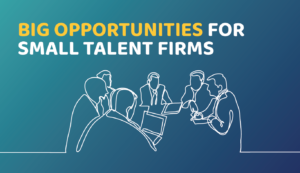Five Lessons from our Candidate Sourcing Webinar
Finding top-quality candidates for your staffing agency and your clients isn’t always easy. Many of the best applicants won’t be actively seeking new jobs, so attracting the best talent for your clients requires strategy, innovation, and flexibility. Staffing agencies and recruiters need to adapt and be open to change in order to succeed.
Our recent webinar covered everything you need to know about sourcing candidates in 2021. It offers expert analysis of the technology, strategies, and trends that are going to shape candidate sourcing in the coming years. If you weren’t able to make it, we’ve summarized some of the key lessons to succeed in a rapidly changing industry.
1. Take a Proactive Approach
Since the beginning of the pandemic and the revolution in remote work that followed, the importance of proactive thinking is top of mind for most recruiters. They are increasingly looking at what new technologies will ultimately drive talent strategy, and how they can best engage workers in a rapidly changing recruiting environment.
The race for talent has been amplified by technology and distributed workforces. A talented software engineer living in Arizona can now be receiving job offers in San Francisco, Berlin, or Melbourne. Building organizational flexibility, a change-positive culture, and thinking proactively about talent strategy and worker engagement is now essential for you and your clients to stand out.
2. Emphasize Human-Centric Technology
The direct outcome of tech implementation in the talent curation process is more access to data and making it faster and easier to work with. But the real benefits of tech lie in giving your team the ability to focus on core competencies and the human element of your operation. Your team can spend more time engaging workers and less time combing through LinkedIn. Going forward, the most effective technological advances will have a human-first approach, and ultimately make things easier for you, your team, and your candidates.
Technology will never replace humans completely, so it is valuable to see technology as an enabler rather than the total solution. Look at your recruitment processes and understand what can be done differently. What could potentially be automated or be done more efficiently?
While the humanized approach is essential, you should still be continuously analyzing your tech stack. Watch how AI and machine-learning innovations are affecting the recruiting industry. Keep your stack upgraded and best in class so your team can focus on the human element, on building relationships, and getting the right candidates to your clients faster.
3. Refine Candidate Communication
Connecting with talent has never been easier, which means competition has also never been higher. This requires innovation in your approach to communicating with candidates to stay ahead of your competitors.
Begin improving your candidate communication by prioritizing omnichannel sourcing. It’s no longer enough to list openings on only one or two channels: you need a strategy that includes job boards, your website, social media content, and referral campaigns to better reach those top candidates that may only be passively searching.
After broadening where you are reaching candidates, rethink how you are connecting with them. Research has shown it is now more effective to reach candidates via text, not phone calls, or even email. That’s a change for a lot of people that have been in the recruiting industry for a long time. If you’re trying to call somebody now, you’ll likely go right to voicemail, as many people don’t even bother answering calls if they don’t recognize the number.
Texting can also be more effective than email. In recruiting light industrial workers, for example, they don’t have their computer in front of them for most of the day, but reliably have access to their phones. They often prefer the convenience of SMS, and you will get quicker responses compared to email or LinkedIn.
4. Leverage Direct Sourcing
We’ve all heard direct sourcing is going to be the death of staffing agencies. We heard that with Monster, CareerBuilder, and LinkedIn. But rather than an existential threat to staffing agencies, direct sourcing platforms are just another tool in the recruiter toolbox to ultimately identify top talent quicker. Work to integrate direct sourcing into your existing successful practices to hit your goals: identifying top talent, presenting it to your client, and ultimately filling roles quickly with the right candidate.
Derek Sanders, Senior Vice President, Enterprise, for People2.0, summarizes how to get the most from direct sourcing platforms:
“If you’re looking at direct sourcing platforms, there are a couple of things to consider. One, make sure it’s a candidate-centric platform because that candidate engagement is critical in terms of being able to attract candidates and making it an easy process for them. Two, they should have two-way SMS texting because, again, that’s going to simplify the process and improve KPIs like fill and response time.”
5. Prioritize Diversity and Inclusion
Companies are increasingly seeking to hire more diverse talent and to work with more diverse firms. This is having a big impact on talent curation and direct sourcing strategies. As a recruiter, you can expect to see more clients looking to partner with agencies that have developed strategic diversity and inclusion talent curation practices.
Nearly two-thirds (64%) believe diversity and inclusion efforts for their employed workforce are a priority, while only a quarter (26%) believe so for contingent workers. However, 63% of respondents expect contingent diversity and inclusion to become a higher priority in the future.
Clients want to know how you’re tracking diversity in the workforce, how your sourcing strategies help to get a good mix of candidates, and how you can help them mitigate biases in the recruitment process. What are you doing differently than you did five years ago? And how do those changes translate to your clients meeting their initiatives? You should be tracking and optimizing your diversity and inclusion initiatives, and be able to share results that back up your strategies.
Interested in learning more? Download a recording of the Best Practices for Candidate Sourcing in 2021 webinar for more talent curation tips and strategies from the experts.



